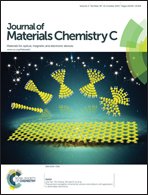A 2D quantum dot-based electrochemiluminescence film sensor towards reversible temperature-sensitive response and nitrite detection†
Abstract
The development of a high-efficiency electrochemiluminescence (ECL) system plays an important role in the fields of chemical sensors and environmental detection. Herein, a CdTe quantum dot (QD)-based thin film (TF) with highly enhanced anodic ECL intensity was developed by combining CdTe with Co–Al-layered double hydroxide (LDH) nanoparticles. Through a layer-by-layer (LBL) process, the as-fabricated CdTe/LDH ECL sensor exhibited a high emissive intensity, good sensitivity and long-term stability, and was further used as a bi-functional sensor for temperature response and nitrite detection. The growth of the CdTe/LDH film was firstly monitored by UV-vis absorption and fluorescence spectra. SEM images showed that the film surface presents a continuous and uniform morphology. A temperature-triggered ECL intensity switch for CdTe/LDH was obtained between 20 and 80 °C with a rather high response sensitivity (−1.92% per °C) and good reversibility. Besides, ECL detection of nitrite anions was performed, and a linear response was obtained in the range of 1 × 10−6 to 1 × 10−2 M with a detection limit of 0.719 μM. Moreover, the CdTe/LDH film for nitrite detection showed a fast, selective and reversible ECL response. Therefore, it is expected that the LBL film in this work can provide an effective way to apply QDs as an anodic ECL system in highly sensitive temperature and nitrite sensors.


 Please wait while we load your content...
Please wait while we load your content...